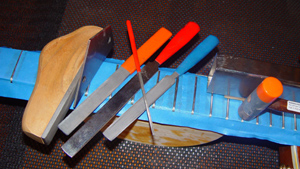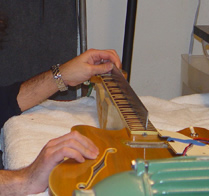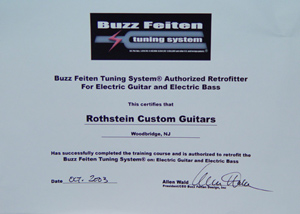Repair Services
Rothstein Guitars offers a variety of high quality repair services for guitars and basses. We pride ourselves on being extremely detail oriented. Our primary goal is to maximize playability and tone. We will treat a $100 yard sale special with the same respect as a Gibson Custom Shop 59 Les Paul. Some of the services and upgrades we perform include:
|
|
 How much will it cost to fix my guitar?
How much will it cost to fix my guitar?
This is very difficult to tell without actually looking at your particular guitar. We charge a shop rate of $75 per hour.
How long will it take to fix my guitar?
It depends on how busy we are at the time, and what is involved. The usual turnaround time for setups is 1 week. If the work involves finishing then a big factor is the weather.
What is a setup?
A setup involves taking several measurements and then adjusting the truss rod, string height at the bridge and nut, and intonation to optimize the playability of your guitar. In addition, we will clean your fretboard, lubricate metal parts, inspect/clean the electronics, and balance your pickups. For more information, see the detailed discussion at the bottom of this page.
How often do I need to have my instrument setup?
Instruments should generally be setup twice a year because wood will expand and contract as the temperature and humidity fluctuates. This is especially true in regions like the North East where summers can be extremely hot and humid, and winters brutally cold.
Can I adjust my instrument myself?
Yes you can, but the difference between a good setup and pro setup is the difference between a guitar that plays pretty well, and a guitar that plays really well. When you pay a tech for a pro setup you are paying for two things. First and foremost you are paying for his/her experience. Secondly, a good tech will have a great deal of tools available that you may not have including an assortment of files, surface ground straight edges, notched straight edges, digital calipers, and the list goes on.
EVERYTHING YOU EVER WANTED TO KNOW ABOUT A GUITAR SETUP
A setup includes the following four critical adjustments:
Relief • String Height at the Bridge • String Height at the Nut • Intonation
RELIEF
 Neck
relief is the introduction of a slight concave curvature to
the neck. The
amount of neck relief required depends upon several factors,
including string height or action as well as the fingerboard
radius. If the string action is high, then no neck relief
is required, but the guitar is too hard to play. While there
is no one set standard for neck relief, as a general guideline
approximately .008" or .012 " of relief measured
at the 7th fret is a good starting point. When the truss rod
is tightened you are straightening the neck and therefore
decreasing the amount of relief. When the rod is loosened
you are increasing the amount of relief. The required number
of turns of the nut depends upon the amount of bow in the
neck as well as the truss rod design. If you are new
to adjusting neck relief, you will observe that the amount
of bow actually affects the string height, however I will
caution you to never adjust the neck relief with the goal
in mind of modifying string height. Neck relief adjustment
should be treated as a separate adjustment that must be made
before adjusting the string height. After the appropriate
neck relief has been set, then you can move on to adjusting
the action.
Neck
relief is the introduction of a slight concave curvature to
the neck. The
amount of neck relief required depends upon several factors,
including string height or action as well as the fingerboard
radius. If the string action is high, then no neck relief
is required, but the guitar is too hard to play. While there
is no one set standard for neck relief, as a general guideline
approximately .008" or .012 " of relief measured
at the 7th fret is a good starting point. When the truss rod
is tightened you are straightening the neck and therefore
decreasing the amount of relief. When the rod is loosened
you are increasing the amount of relief. The required number
of turns of the nut depends upon the amount of bow in the
neck as well as the truss rod design. If you are new
to adjusting neck relief, you will observe that the amount
of bow actually affects the string height, however I will
caution you to never adjust the neck relief with the goal
in mind of modifying string height. Neck relief adjustment
should be treated as a separate adjustment that must be made
before adjusting the string height. After the appropriate
neck relief has been set, then you can move on to adjusting
the action.
Here is a little graphic depicting problems with either too much or too little relief.
STRING HEIGHT AT THE BRIDGE
You must measure the distance between the top of the twelfth fret to the bottom of each string under string tension. Acceptable action for a guitar is generally between 3/64" and 5/64". How low can you go? Well this depends on several factors including the fingerboard radius and how level the frets are. It is impossible to get very low action on a vintage 7 1/4" radius if the player does a lot of bending. Bends will invariably "note out" due to the dramatic radius . It the frets aren't level you also don't have a prayer at getting low action.
STRING HEIGHT AT THE NUT
Once the neck relief and the string height at the bridge have been set, the string height at the nut can be looked at. Two questions need to be addressed:
- Is the height at the nut too high? If the guitar is harder to play in the first couple of frets, then the height at the nut is probably too height.
- Is the height at the nut too low? The typical scenario where I suspect the height at the nut is too low is when open strings vibrate against the first fret. A good test is to depress each string at the 3rd fret, and then inspect to see if any gap exists between the top of the 1st fret and bottom of each string. If there is no gap then the nut is obviously too low. Another age old test is to depress each string at the 3rd fret, and then tap each string against the1st fret. If you hear a slight "ping" it means three is a gap and the string is clicking against the fret which is a good sign. If you hear no "ping" then the nut is likely too low.
INTONATION
Intonation is the ability for an instrument to play in tune. The standard way to adjust intonation (as opposed to the tempered tuning approach utilized by the Buzz Feiten System®) is to compare the pitch of an open string, to that of the same note played an octave higher at the 12th fret. If the note at the 12th fret is sharp, we then move the saddle back. If the note at the 12th fret is flat, we then move the saddle forward.
The Problem - Even though your guitar has been intonated, it doesn't play in tune up and down the entire neck
Tell me if you have ever experienced this: You tune up and proceed to play a basic E chord at the first fret and it sounds perfectly in tune. Next you play basic A and D chords and at least one or two notes are either sharp or flat. It is maddening! No matter how carefully you tune your guitar, you can't compensate for this 'brick wall' in intonation. Most of us have learned how to play around the bad notes or avoid certain notes and chords altogether.
The Reason - Standard intonation is not pleasing to the ear
Guitars are designed and built using a standard formula for intonation and nut placement. Each string is intonated only to itself resulting in an attempt to create perfect, mathematical intervals. Piano tuners abandoned the use of perfect mathematical intervals over 400 years ago because it simply is not pleasing to the ear. Instead, piano strings are 'stretch tuned' so that the intonation is pleasing anywhere on the keyboard. The resulting 'tempered' tuning is superbly musical, and most important, in tune with the ear at all intervals. A properly tuned piano provides the absolute pitch reference for all instruments.
The Solution - The Buzz Feiten Tuning System®
Inspired by the piano's tempered tuning, the Buzz Feiten Tuning System is a revolutionary intonation model for guitar that intonates each string not only to itself, but also to every other string. Furthermore, to eliminate sharpness in the first three frets (referred to as end tension), the nut is moved a prescribed distance closer to the bridge. The result - play any note, any chord, anywhere on the neck and you'll be in tune. And, it doesn't change the way your guitar looks or plays.
Retrofit Your Guitar with the Buzz Feiten Tuning System®
Rothstein Guitars is an Authorized Retro fitter for the Buzz Feiten Tuning System® . It's easy, affordable, and totally non-invasive on electric guitars. And your guitar will look, play and feel the same.
The Buzz Feiten Tuning System® Authorized Retrofit involves two steps:
Step 1: Install Shelf Nut
The nut is moved closer to the first fret to eliminate sharpness at the first three frets caused by end tension. The Feiten Shelf Nut is installed according to a patented formula for your guitar based on its scale length, fret width and string gauge. The Shelf Nut is machined from only the finest, natural bone for the absolute best in tonal transfer.
Step 2: Intonation
Your guitar is intonated according to the Feiten patented pitch offset formulas using either a Peterson Strobe, or Korg DT-7 Tuner in Buzz Feiten Tuning System mode. This step is performed by adjusting the bridge saddles until each string is properly intonated according to the pitch offset formulas. These slight, but exacting adjustments, when combined with the Shelf Nut bring your guitar into proper, balanced intonation across the entire fingerboard of your guitar. Your guitar's original bridge is used so there is no alteration in its look, feel or tone.




